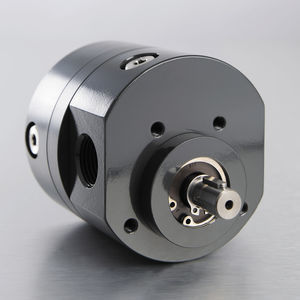
- Hydraulics - Pneumatics
- Pump
- Coolant pump
- Beinlich Pumpen
Internal-gear pump ZPIfor coolantstationaryfor petrochemical applications

Add to favorites
Compare this product
Characteristics
- Fluid
- for coolant
- Technology
- internal-gear
- Mobility
- stationary
- Domain
- for petrochemical applications
- Applications
- conveying
- Material
- cast iron
- Fluid specification
- for mineral oil
- Protection level
- oil-resistant
- Other characteristics
- high-efficiency, low-noise
- Flow
Min.: 0 l/min
(0 us gal/min)Max.: 41.4 l/min
(10.93672 us gal/min)- Pressure
Min.: 0 bar
(0 psi)Max.: 120 bar
(1,740.453 psi)- Fluid temperature
Min.: -20 °C
(-4 °F)Max.: 150 °C
(302 °F)
Description
Internal gear pump ZPI
Thanks to internal gear wheels, the gear pump ZPI allows an especially low-noise conveying of the fluid which not only reduces the noise emission but also the costs for noise-absorbing measures.
Furthermore, the high volumetric efficiency of the ZPI internal gear pump has a positive effect on the energy balance due to the improvement of the overall efficiency.
Performance data
Displacements 1.00 up to 207.00 cc/rev
Speed 300 up to 3,000 rpm
Viscosity 10 up to 1,000 mPas
Ambient temperature range -30°C up to +60°C
Medium temperature / operating temperature -20°C up to +150°C
Operating pressure up to 120 bar
Application areas
Low noise hydraulic drives
Coolant pumps for machine tools
„Overdrive pumps“ for hydraulic presses in combination with Beinlich radial piston pumps
Advantages of the internal gear pump ZPI
Low pulsation
Low noise operation
Long service life
High volumetric efficiency
Catalogs
ZPI Internal gear pumps
4 Pages
Exhibitions
Meet this supplier at the following exhibition(s):

Related Searches
- Beinlich pump
- Industrial pump
- Pump with electric motor
- Beinlich stationary pump
- Clear water pump
- Self-priming pump
- Chemical pump
- Stainless steel pump
- Lubricant pump
- Submersible pump
- Chemistry pump
- Lubricating oil pump
- Compact pump
- Piston pump
- Cast iron pump
- Metering pump
- Standard pump
- High-pressure pump
- High-efficiency pump
- Pump for oil industry applications
*Prices are pre-tax. They exclude delivery charges and customs duties and do not include additional charges for installation or activation options. Prices are indicative only and may vary by country, with changes to the cost of raw materials and exchange rates.




